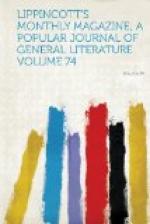Call frequently,
Drink moderately,
Pay honourably,
Be good company,
Part friendly,
Go home quietly.
Arrived at the close of the second day in Canterbury, the two “toke” their inn at the sign of the “Falstaff,” where hung “Honest Jack, in buff doublet and red hose,” in a wonderful piece of wrought-iron work. Whether next day, after viewing the cathedral, the tricycles pursued their journey, is not told. The pilgrimage ends, as it should, at the shrine,—that is, where the shrine had been; for the verger, after saying solemnly that they had come to the shrine of St. Thomas, solemnly added, “’Enery the Heighth, when he was in Canterbury, took the bones, which they was laid beneath, out on the green, and had them burned. With them he took the ’oly shrine, which it and bones is here no longer.”
* * * * *
Fiction.
“The Lady with the Rubies.” Translated from the German of E. Marlitt by Mrs. A.L. Wister. Philadelphia: J.B. Lippincott Company.
“Barbara Heathcote’s Trial.” By Rosa Nouchette Carey. Philadelphia: J.B. Lippincott Company.
“The Bar Sinister. A Social Study.” New York: Cassell & Co.
“Pine-Cones.” By Willis Boyd Allen. Boston: D. Lothrop & Co.
“An Old Maid’s Paradise.” By Elizabeth Stuart Phelps. Boston: Houghton, Mifflin & Co.
In spite of all the clever pleas urged by the lovers of realism for realistic novels, it is easy enough to see that the mass of readers are just as much in love as ever with a high romanticism, and Miss Marlitt’s stories still retain the strong hold they first took of the popular heart. The success of fiction comes from the fact that it supplies a want existing in most people’s minds: lively incidents to awaken and stimulate the fancy, a touch of mystery to give a thrill of pleasing fear, sharply diversified characters impelled by strong motives which insure a lively conflict of passions,—all these are what the average novel-reader demands, and finds in Miss Marlitt’s works. A great rambling German house, with suites of disused apartments shut away from sunshine and air and haunted by vanished forms and silent voices, while its open rooms are tenanted by a nest of gentlefolks of all degrees of relation,—some united by love, and others at swords’-points,—offers a lively field for the romancer; and such is the scene in “The Lady with the Rubies.” “Belief in the Powers of Darkness will never die so long as poor human hearts love, hope, and fear,” is the moral, so to speak, of the book; and the author has used with good effect this vein of superstition which “makes the whole world kin.” Little Margarete’s encounter with the family spectre, her flight from home, her lonely and terrifying night, are touchingly described; and, in fact, the book is full of pretty child-pictures, which enhance the pleasantness and charm of the love-story. Few of Miss Marlitt’s books possess more interest and diversity than “The Lady with the Rubies;” and, as usual with Mrs. Wister’s work, it is well and gracefully translated.




